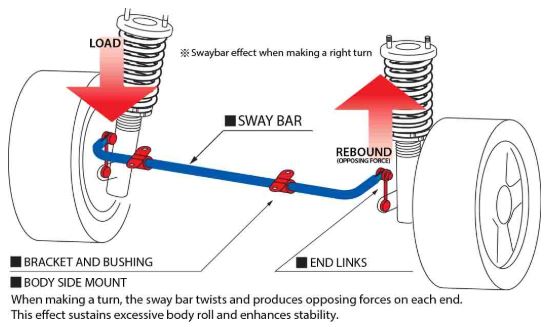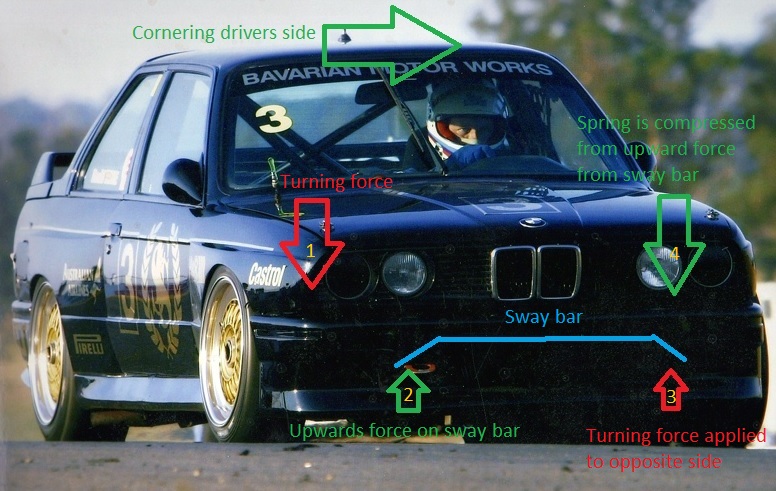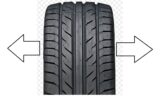Most results when searching topics about sway bars involve high level extrapolations about understeer, oversteer, body roll and preferences; all important but it doesn’t help to understand how sway bars actually work.
Hopefully I can simplify it enough where it starts to make intuitive sense.
The primary principle behind a sway bar is to allow for two otherwise independent suspension systems (left and right) to be tied together. When corning; the loaded side effectively steals additional spring rate from the opposite side spring; therefore distributing the load left to right equally.
Wait, equally? Whats the point of a thicker or thinner sway bar than?
Well, as per newtons third law, every action has an equal and opposite reaction. A bar under torsion acts like a spring, where any force applied on one end will without loss of force given enough time transfer to the other side.
Its the same principle for why a socket extension on a torque wrench does not cause the torque wrench to lose accuracy:
What this means is, unless the sway bar is so thin that it gets permanently bent, if you keep cornering, a thin bar and thick bar given enough time will demonstrate the exact same amount of body roll on a vehicle.
The difference is that a thicker bar, which has higher torsional strength will steal the effective additional rate from the other side quicker.
In the illustration above, quicker denotes the amount of time it takes any given amount of force to make it from point 1 to point 4. Thicker bar = quicker, thinner bar = slower, but given enough time regardless of bar thickness, force on point 1 and point 4 will always match.
Therefore, if you want to test how much total effect instead of momentary effect a thicker sway bar may have on your car, go to a parking lot and do an endless turn in one direction. Where the car settles is your maximum anti roll potential without changing springs.
If your goal is to reduce total body roll and not momentary body roll, a bigger sway bar will not help, you will need stiffer springs. The thicker bar will only reduce the time between momentary body roll and total body roll.
With a bigger sway bar, because the time it takes to go from step 1 to step 4 is quicker, it may have a tendency to cause understeer (large front), or oversteer (larger rear) because there is a trade off between momentary suspension travel/articulation and the counter force from the sway bar. The actual effect on oversteer/understeer will be highly dependent on what kind of roads you are driving on.
This is particularly obvious in the offroading world where travel is important:
On a smooth flat road, there will be negligible difference between understeer and oversteer with a larger bar, and vice versa on roads with imperfections.
So you’re thinking alright, time to get some bigger sway bars. What size should I get?
Thats up to preference, however let me enable you to determine just how much stiffer you’re going relative to your current set up by going up X number of millimeters.
Lets take an 325is E30 for example. It comes with a 20mm front sway bar and a 12mm rear sway bar from the factory.
The torsional strength difference is calculated as ((newswaybarsize / oldswaybarsize)^4)-1. So if we wanted to put a 22mm up front, we would calculate ((22 / 20)^4)-1 = 0.4641 meaning a 22mm bar will be 45.41% stiff than a 20mm. Big difference, right?
Ever wondered why everyone has a problem with sway bar mounts breaking off when they go from the OEM 12mm rear to a 19mm rear (H&R, IE, ST Suspension, Etc) on their e30? Well that’s not because the rear mounts are weak, its because by going from 12.5mm to 19mm your going up 528.5% (((19 / 12)^4)-1 = 5.285) in stiffness.
Every mm has a big difference; don’t be surprised when 528.5% in stiffness translates to broken sway bar mounts.
Front sway bars are not comparable between M3 and non M3 as they have different length and style sway bars. But, looking at the rear sway bars which are interchangeable, it makes a lot more sense that the E30 M3 has a 14.5mm rear sway bar; it may seem like a small increase, but really, a 14.5mm sway bar is (14.5/12)^4-1 = 1.132 or 113.2% stiffer.
For the sake of balance, a 24mm front bar would mean a 107.4% increase in stiffness, which would match great with the 113.2% increase of a 14.5mm rear.
This logic and calculation applies to all cars and sway bars. Use it to figure out how much larger you need to go to reach your stiffness preference level, and use it to ensure you keep front and rear balanced, or as a tool to skew the balance between front and rear.






IWE have A 2021 Ram 1500 Crew Cab Classic Warlock we use for Canine and Search and rescue. Officers have found in severak instnces at high speed..80moh on corners in pursuits, the truck would roll slightly. With yiur calculations would you suggest a thicker rear anti sway pbar for the safty of the officer and K9’s..
he Warlock is a standard equipped 5.7 Hemi with no other enhancements. OI bwloeve the only factor we know of is the Warlock is 1 inch taller fron the manufacturer.
Thanks you Sgt. Haddon